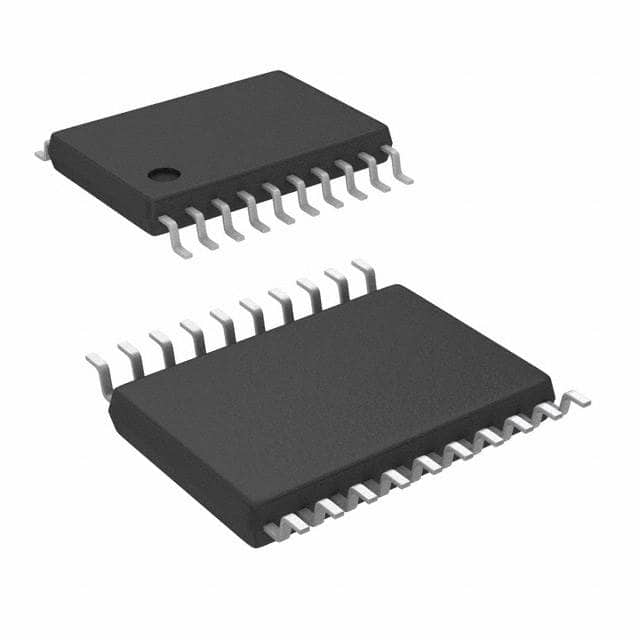AD7998BRUZ-1
Product Overview
Category
The AD7998BRUZ-1 belongs to the category of analog-to-digital converters (ADCs).
Use
It is primarily used for converting analog signals into digital data.
Characteristics
- High-resolution ADC with 12-bit resolution
- Low power consumption
- I2C-compatible interface
- Eight input channels
- Programmable gain amplifier (PGA)
- Internal reference voltage
- Small package size
Package and Quantity
The AD7998BRUZ-1 is available in a 16-lead TSSOP package. It is typically sold in quantities of one or more.
Essence
The essence of the AD7998BRUZ-1 lies in its ability to accurately convert analog signals into digital form, making it suitable for various applications that require precise measurements.
Specifications
- Resolution: 12 bits
- Input Channels: 8
- Supply Voltage Range: 2.7V to 5.5V
- Conversion Time: 3.6 µs per channel
- Operating Temperature Range: -40°C to +85°C
- Interface: I2C-compatible
Pin Configuration
The AD7998BRUZ-1 has a total of 16 pins. The pin configuration is as follows:
Pin 1: VDD
Pin 2: SDA
Pin 3: SCL
Pin 4: ADDR0
Pin 5: ADDR1
Pin 6: ADDR2
Pin 7: ALERT
Pin 8: GND
Pin 9: AIN0
Pin 10: AIN1
Pin 11: AIN2
Pin 12: AIN3
Pin 13: AIN4
Pin 14: AIN5
Pin 15: AIN6
Pin 16: AIN7
Functional Features
- High-resolution conversion for accurate measurements
- Multiple input channels for versatile applications
- Programmable gain amplifier allows for signal amplification
- I2C-compatible interface enables easy communication with microcontrollers
- Low power consumption for energy-efficient operation
- Internal reference voltage ensures stable and reliable conversions
Advantages and Disadvantages
Advantages
- High resolution provides precise measurement capabilities
- Versatile input channels allow for flexible usage
- Low power consumption extends battery life in portable applications
- I2C-compatible interface simplifies integration with microcontrollers
- Internal reference voltage ensures accuracy and stability
Disadvantages
- Limited to 8 input channels, may not be suitable for applications requiring more inputs
- Conversion time of 3.6 µs per channel may be slower compared to other ADCs
- Requires external components for proper operation (microcontroller, power supply, etc.)
Working Principles
The AD7998BRUZ-1 operates by sampling the analog input signals and converting them into digital data using its internal ADC. The programmable gain amplifier allows for signal amplification, enhancing the measurement accuracy. The converted digital data is then transmitted through the I2C-compatible interface for further processing or analysis.
Application Field Plans
The AD7998BRUZ-1 can be used in various applications that require accurate analog-to-digital conversion. Some potential application fields include:
- Industrial automation: Monitoring and control systems that require precise measurements of physical parameters such as temperature, pressure, or flow.
- Medical devices: Measurement and monitoring of vital signs, patient diagnostics, and laboratory equipment.
- Test and measurement equipment: Data acquisition systems, oscilloscopes, and multimeters that require high-resolution measurements.
- Energy management: Smart grid systems, energy monitoring, and power quality analysis.
- Automotive electronics: Sensor data acquisition, engine control units, and battery management systems.
Alternative Models
- AD7991: 8-channel, 10-bit ADC with I2C interface
- AD7992: 4-channel, 12-bit ADC with I2C interface
- AD7993: 4-channel, 10-bit ADC with I2C interface
- AD7994: 4-channel, 8-bit ADC with I2C interface
- AD7995: 2-channel, 12-bit ADC with I2C interface
These alternative models offer different channel configurations and resolutions to suit specific application requirements.
In conclusion, the AD7998BRUZ-1 is a high-resolution analog-to-digital converter that provides accurate measurements in various applications. Its versatile input channels, low power consumption, and I2C-compatible interface make it a suitable choice for many projects. However, its limited number of input channels and conversion time may be limiting factors in certain scenarios.
Lista 10 Vanliga frågor och svar relaterade till tillämpningen av AD7998BRUZ-1 i tekniska lösningar
Sure! Here are 10 common questions and answers related to the application of AD7998BRUZ-1 in technical solutions:
Q1: What is the AD7998BRUZ-1? A1: The AD7998BRUZ-1 is a 8-channel, 12-bit analog-to-digital converter (ADC) with I2C interface.
Q2: What is the supply voltage range for the AD7998BRUZ-1? A2: The supply voltage range for the AD7998BRUZ-1 is 2.7V to 5.5V.
Q3: How many analog input channels does the AD7998BRUZ-1 have? A3: The AD7998BRUZ-1 has 8 analog input channels.
Q4: What is the resolution of the AD7998BRUZ-1? A4: The AD7998BRUZ-1 has a resolution of 12 bits.
Q5: What is the maximum sampling rate of the AD7998BRUZ-1? A5: The AD7998BRUZ-1 has a maximum sampling rate of 100 kilosamples per second (ksps).
Q6: Does the AD7998BRUZ-1 have built-in reference voltage? A6: Yes, the AD7998BRUZ-1 has a built-in reference voltage of 2.5V.
Q7: Can the AD7998BRUZ-1 operate in both single-ended and differential mode? A7: Yes, the AD7998BRUZ-1 can operate in both single-ended and differential mode.
Q8: What is the I2C address of the AD7998BRUZ-1? A8: The I2C address of the AD7998BRUZ-1 is 0x29.
Q9: Can the AD7998BRUZ-1 be used in battery-powered applications? A9: Yes, the AD7998BRUZ-1 can be used in battery-powered applications due to its low power consumption.
Q10: Does the AD7998BRUZ-1 have any built-in programmable features? A10: Yes, the AD7998BRUZ-1 has built-in programmable features such as channel sequencing and conversion averaging.
Please note that these answers are based on general information about the AD7998BRUZ-1. It's always recommended to refer to the datasheet and consult with the manufacturer for specific technical details and application requirements.


